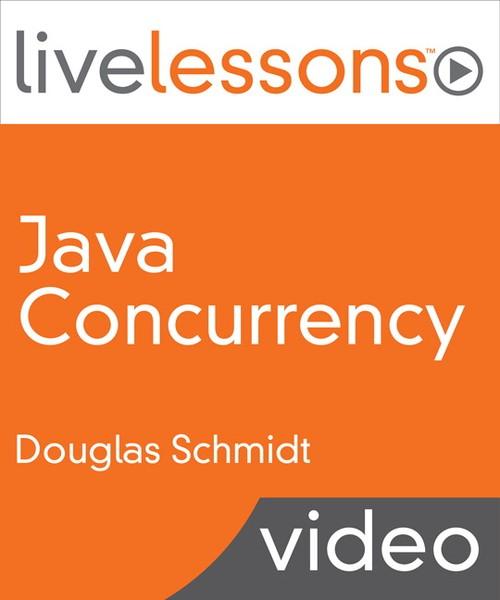Oreilly - Java Concurrency LiveLessons (Video Training)
by | Released May 2015 | ISBN: 013407095X
4+ Hours of Video InstructionJava Concurrency LiveLessons teaches how to develop high-quality concurrent software applications and reusable frameworks through the use of patterns, object-oriented design techniques, and Java programming language features.DescriptionThe confluence of multi-core and distributed-core processors, inexpensive mass storage, ubiquitous connectivity, and commodity software platforms is driving the need for software engineers and programmers who understand how to develop concurrent software for client devices that connect to cloud computing platforms. Despite many improvements in processors, storage, and networks, however, developing quality software on-time and on-budget remains hard. Moreover, developing high-quality concurrent software apps and reusable services is even harder.This Java Concurrency LiveLessons describes by example how to apply patterns and frameworks to alleviate the complexity of developing concurrent software via the use of object-oriented design techniques and Java programming language features and class libraries. Many Java application examples are used throughout the course to showcase pattern-oriented design and programming techniques for concurrent software.About the InstructorDr. Douglas C. Schmidt is the original developer of ACE and The ACE ORB (TAO). He is a professor at Vanderbilt University, where he studies patterns, optimizations, middleware, and model-based tools for distributed real-time and embedded systems. He is a former editor-in-chief of C++ Report and columnist for C/C++ Users Journal. Doug has coauthored four books, including C++ Network Programming, Volume 1 and 2(Addison-Wesley), Pattern Languages in Programming Design (Addison-Wesley), and Pattern-Oriented Software Design (Wiley). He also authored the video training course Design Patterns in Java LiveLessons (Addison-Wesley).Skill LevelIntermediate to AdvancedWhat You Will LearnRecognize the inherent and accidental complexities involved with developing concurrent software for Java clients and servers.Understand how pattern-oriented software architecture techniques can and cannot help to alleviate this complexity.Apply key pattern-oriented software architecture techniques to develop reusable concurrent software using Java object-oriented programming language features and class libraries.Know where to find additional sources of information on how to successfully apply pattern-oriented software architecture techniques to concurrent software in Java.Who Should Take This CourseDevelopers looking for practical coverage of developing pattern-oriented concurrent software with JavaCourse RequirementsFamiliar with general object-oriented design and programming concepts such as encapsulation, abstraction, polymorphism, extensibility, and the Unified Modeling Language (UML).Familiar with fundamental object-oriented programming language features such as classes, inheritance, dynamic binding, and parameterized types available in Java, C++, and C#.Table of ContentsLesson 1: Overview of Java ConcurrencyThe first lesson presents an overview of concurrency and concurrent programming in Java. This lesson first explores the motivations for concurrency and then outlines key layers in the Java architecture, focusing on how these layers support the needs of concurrent programs on a range of computing devices. Next, the lesson shows how the benefits of concurrency make it worth the time and effort needed to master the complexities of concurrent programming in Java. This lesson focuses primarily on concepts, although it does show several examples of concurrent Java code to illustrate key points.Lesson 2: Java Threading Mechanisms and FrameworksLesson 2 covers how to develop concurrent programs, the computations of which run simultaneously on one or more processor cores. This lesson first focuses on the mechanisms that Java provides to create, control, and terminate multiple threads, which are the units of computation that can be scheduled to run concurrently within a process. After covering the basics of Java threads, the lesson delves deeper into their structure and functionality, focusing on the key states in their lifecycle and showing how to manage them effectively. Finally, the lesson covers the powerful services provided by the Java Executor framework, which decouples the creation and management of threads from the rest of the application logic. This framework also supports a range of fixed and variable-sized thread pools that run efficiently on modern multicore processors. Throughout this lesson, viewers see how concurrent Java applications and frameworks are developed by applying many Gang of Four and POSA patterns.Lesson 3: Java Synchronization MechanismsLesson 3 covers the capabilities that Java provides to ensure interactions between threads running computations concurrently occur in the right order, at the right time, and don't accidentally corrupt shared data. The synchronization mechanisms covered in this lesson are based on standard Java programming language features and standard classes provided by the java.util.concurrent package. The lesson analyzes many sample mechanisms, both in applications and the java.util.concurrent package itself. Viewers learn how to develop correct and efficient concurrent programs, as well as how to understand common problems that arise when these mechanisms are applied incorrectly. The lesson also discusses how Java synchronization mechanisms are enhanced by applying many Gang of Four and POSA patterns.Lesson 4: Case Studies of Concurrent Programming in Java Lesson 4 provides in-depth analysis of how the Java threading and synchronization mechanisms covered in earlier lessons can be applied in practice. The first case study explores the design and implementation of a pattern-oriented framework containing two Java threads that alternate printing ping and pong on several types of computing displays. This example shows how the framework enables the use of multiple Java synchronizers to configure and coordinate the proper interactions between the ping and pong threads, as well as the main thread. The second case study analyzes the structure and functionality of another pattern-orientated framework that uses a pool of threads created and managed by the Java Executor framework, together with various Java synchronization mechanisms to mediate concurrent access to a fixed-size pool of resources. Once again, this executor can configure and use a range of Java synchronizers. The third case study explores the design and implementation of an application that downloads image content from remote web servers via various Java threading mechanisms and frameworks, including the Java ExecutorCompletionService framework. Lesson 5: Source Code Analysis of java.util.concurrent Classes Lesson 5 explores how Java's threading and synchronization mechanisms are programmed internally. The first part of this lesson focuses on the structure and functionality of the Java Executor framework, including the various thread pool executors and the ExecutorCompletionService. The lesson also shows how these core Java framework classes are supported by various other classes, such as Future and FutureTask. The second part of this lesson analyzes the design and implementation of core Java synchronizers, such as ReentrantLock, ConditionObject, and Semaphore. As part of this analysis, we cover the structure and functionality of Java's AbstractQueueSynchronizer class. The lesson doesn't analyze every class or every line of code but instead focuses on the key patterns and idioms used to guide the implementation of classes in the java.util.concurrent package. Understanding the design and implementation of these classes can help programmers understand the patterns and best practices of developing software that uses Java's concurrency capabilities effectively and efficiently. About LiveLessons Video Training The LiveLessons Video Training series publishes hundreds of hands-on, expert-led video tutorials covering a wide selection of technology topics designed to teach you the skills you need to succeed. This professional and personal technology video series features world-leading author instructors published by your trusted technology brands: Addison-Wesley, Cisco Press, IBM Press, Pearson IT Certification, Prentice Hall, Sams, and Que. Topics include: IT Certification, Programming, Web Development, Mobile Development, Home and Office Technologies, Business and Management, and more. View all LiveLessons on InformIT at: http://www.informit.com/livelessons. Show and hide more
- Introduction
- Java Concurrency LiveLessons: Introduction 00:04:22
- Lesson 1: Overview of Java Concurrency
- Learning Objectives 00:02:34
- 1.1 Understand motivations for--and layers of--the Java architecture for concurrent software 00:09:44
- 1.2 Understand the key benefits of developing concurrent software 00:10:14
- 1.3 Recognize the inherent complexities of concurrent software 00:12:49
- 1.4 Recognize the accidental complexities of concurrent software 00:10:27
- Putting all the pieces together 00:04:06
- Lesson 2: Java Threading Mechanisms and Framworks
- Learning Objectives 00:01:45
- 2.1 Recognize the Java threading mechanisms available to program concurrent software 00:26:18
- 2.2 Understand the Java Thread lifecycle and how to manage it effectively 00:11:52
- 2.3 Comprehend how the Java Executor framework decouples thread management and creation from the rest of the application--Part 1 00:19:01
- 2.3 Comprehend how the Java Executor framework decouples thread management and creation from the rest of the application--Part 2 00:20:02
- 2.3 Comprehend how the Java Executor framework decouples thread management and creation from the rest of the application--Part 3 00:20:53
- Putting all the pieces together 00:01:36
- Lesson 3: Java Synchronization Mechanisms
- Learning Objectives 00:01:51
- 3.1 Understand the key Java synchronization classes in concurrent programs 00:11:53
- 3.2 Provide lock-free, thread-safe programming for single variables with Java atomic variables and operations 00:08:39
- 3.3 Ensure mutual exclusion and cooperation between threads with Java built-in monitor objects 00:17:47
- 3.4 Provide mutual exclusion mechanisms to concurrent programs with Java ReentrantLock 00:09:45
- 3.5 Provide readers-writer lock mechanisms to concurrent programs with Java ReentrantReadWriteLock and StampLock--Part 1 00:16:09
- 3.5 Provide readers-writer lock mechanisms to concurrent programs with Java ReentrantReadWriteLock and StampLock--Part 2 00:08:23
- 3.6 Enable multiple threads to control access to a limited number of shared resources with Java Semaphore 00:09:32
- 3.7 Enable concurrent programs to have multiple wait-sets per user-defined object with Java ConditionObject 00:12:23
- 3.8 Enable one or more threads to wait for operations performed in other threads to complete with Java CountDownLock, CyclicBarrier, and Phaser barrier synchronizers 00:30:54
- Putting all the pieces together 00:02:12
- Lesson 4: Case Studies of Concurrency Programming in Java
- Learning Objectives 00:01:47
- 4.1 Understand the design and implementation of a concurrent ping/pong application 00:30:27
- 4.2 Understand the design and implementation of a concurrent resource management application 00:28:48
- 4.3 Understand the design and implementation of a concurrent content downloading application 00:31:50
- Lesson 5: Source Code Analysis of java.util.concurrent Classes
- Learning Objectives 00:01:46
- 5.1 Analyze the implementation of Java threading mechanisms 00:31:34
- 5.2 Analyze the implementation of Java synchronization mechanisms--Part 1 00:27:58
- 5.2 Analyze the implementation of Java synchronization mechanisms--Part 2 00:15:08
- Summary
- Java Concurrency LiveLessons: Summary 00:03:03
Show and hide more
9780134070957.java.concurrency.livelessons.OR.part1.rar
9780134070957.java.concurrency.livelessons.OR.part2.rar
9780134070957.java.concurrency.livelessons.OR.part3.rar
9780134070957.java.concurrency.livelessons.OR.part4.rar

































